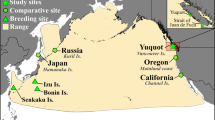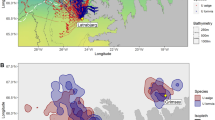Abstract
An optimal search theory, the so-called Lévy-flight foraging hypothesis1, predicts that predators should adopt search strategies known as Lévy flights where prey is sparse and distributed unpredictably, but that Brownian movement is sufficiently efficient for locating abundant prey2,3,4. Empirical studies have generated controversy because the accuracy of statistical methods that have been used to identify Lévy behaviour has recently been questioned5,6. Consequently, whether foragers exhibit Lévy flights in the wild remains unclear. Crucially, moreover, it has not been tested whether observed movement patterns across natural landscapes having different expected resource distributions conform to the theory’s central predictions. Here we use maximum-likelihood methods to test for Lévy patterns in relation to environmental gradients in the largest animal movement data set assembled for this purpose. Strong support was found for Lévy search patterns across 14 species of open-ocean predatory fish (sharks, tuna, billfish and ocean sunfish), with some individuals switching between Lévy and Brownian movement as they traversed different habitat types. We tested the spatial occurrence of these two principal patterns and found Lévy behaviour to be associated with less productive waters (sparser prey) and Brownian movements to be associated with productive shelf or convergence-front habitats (abundant prey). These results are consistent with the Lévy-flight foraging hypothesis1,7, supporting the contention8,9 that organism search strategies naturally evolved in such a way that they exploit optimal Lévy patterns.
This is a preview of subscription content, access via your institution
Access options
Subscribe to this journal
Receive 51 print issues and online access
$199.00 per year
only $3.90 per issue
Buy this article
- Purchase on Springer Link
- Instant access to full article PDF
Prices may be subject to local taxes which are calculated during checkout



Similar content being viewed by others
References
Viswanathan, G. M., Raposo, E. P. & da Luz, M. G. E. Lévy flights and superdiffusion in the context of biological encounters and random searches. Phys. Life Rev. 5, 133–150 (2008)
Viswanathan, G. M. et al. Optimizing the success of random searches. Nature 401, 911–914 (1999)
Bartumeus, F. et al. Optimizing the encounter rate in biological interactions: Lévy versus Brownian strategies. Phys. Rev. Lett. 88, 097901 (2002)
Bartumeus, F., Da Luz, M. G. E., Viswanathan, G. M. & Catalan, J. Animal search strategies: a quantitative random-walk analysis. Ecology 86, 3078–3087 (2005)
Sims, D. W., Righton, D. & Pitchford, J. W. Minimising errors in identifying Lévy flight behaviour of organisms. J. Anim. Ecol. 76, 222–229 (2007)
Edwards, A. M. et al. Revisiting Lévy flight search patterns of wandering albatrosses, bumblebees and deer. Nature 449, 1044–1048 (2007)
Bartumeus, F. Lévy processes in animal movement: an evolutionary hypothesis. Fractals 15, 151–162 (2007)
Travis, J. Ecology: do wandering albatrosses care about math? Science 318, 742–743 (2007)
Buchanan, M. Ecological modelling: the mathematical mirror to animal nature. Nature 453, 714–716 (2008)
Shlesinger, M. F. & Klafter, J. in On Growth and Form (eds Stanley, H. & Ostrowsky, N.) 279–283 (Kluwer, 1986)
Shlesinger, M. F., Zaslavsky, G. M. & Klafter, J. Strange kinetics. Nature 363, 31–37 (1993)
Viswanathan, G. M. et al. Lévy flight search patterns of wandering albatrosses. Nature 381, 413–415 (1996)
Sims, D. W. et al. Scaling laws of marine predator search behaviour. Nature 451, 1098–1102 (2008)
White, E. P., Enquist, B. J. & Green, J. L. On estimating the exponent of power-law frequency distributions. Ecology 89, 905–912 (2008)
Edwards, A. M. Using likelihood to test for Lévy flight search patterns and for general power-law distributions in nature. J. Anim. Ecol. 77, 1212–1222 (2008)
Clauset, A., Shalizi, C. R. & Newman, M. E. J. Power-law distributions in empirical data. SIAM Rev. 51, 661–703 (2009)
Benhamou, S. How many animals really do the Lévy walk? Ecology 88, 1962–1969 (2007)
Bartumeus, F. & Catalan, J. Optimal search behavior and classic foraging theory. J. Phys. A 42, 434002 (2009)
Viswanathan, G. M. et al. Lévy flights in random searches. Physica A 282, 1–12 (2000)
Cornelius, J. M. & Reynolds, J. F. On determining the statistical significance of discontinuities within ordered ecological data. Ecology 72, 2057–2070 (1991)
Behrenfeld, M. J. & Falkowski, P. G. Photosynthetic rates derived from satellite-based chlorophyll concentration. Limnol. Oceanogr. 42, 1–20 (1997)
Sims, D. W. et al. Encounter success of free-ranging marine predator movements across a dynamic prey landscape. Proc. R. Soc. B 273, 1195–1201 (2006)
Clarke, M. R. & Stevens, J. D. Cephalopods, blue sharks and migration. J. Mar. Biol. Assoc. UK 54, 949–957 (1974)
Moteki, M., Arai, M., Tsuchiya, K. & Okamoto, H. Composition of piscine prey in the diet of large pelagic fish in the eastern tropical Pacific Ocean. Fish. Sci. 67, 1063–1074 (2001)
Zainuddin, M., Kiyofuji, H., Saitoh, K. & Saitoh, S. I. Using multi-sensor satellite remote sensing and catch data to detect ocean hot spots for albacore (Thunnus alalunga) in the northwestern North Pacific. Deep-Sea Res. II 53, 419–431 (2006)
Powell, T. M. et al. Spatial scales of current speed and phytoplankton biomass fluctuations in Lake Tahoe. Science 189, 1088–1090 (1975)
Boyer, D. et al. Scale-free foraging by primates emerges from their interaction with a complex environment. Proc. R. Soc. B 273, 1743–1750 (2006)
Bartumeus, F. et al. Helical Lévy walks: adjusting searching statistics to resource availability in microzooplankton. Proc. Natl Acad. Sci. USA 100, 12771–12775 (2003)
Kashtan, N., Noor, E. & Alon, U. Varying environments can speed up evolution. Proc. Natl Acad. Sci. USA 104, 13711–13716 (2007)
Acknowledgements
This research was facilitated through the European Tracking of Predators in the Atlantic programme in the European Census of Marine Life. Funding was provided by the UK Natural Environment Research Council (NERC) Oceans 2025 Strategic Research Programme (Theme 6 Science for Sustainable Marine Resources), the Save Our Seas Foundation, the Leverhulme Trust, the UK Department for Environment Food and Rural Affairs, Fundação para a Ciência e a Tecnologia grant SFRH/BD/21354/2005, the UK Royal Society, the Fisheries Society of the British Isles, the Údarás na Gaeltachta, the Taighde Mara Teo, the Marine Institute (Ireland), the Irish Research Council for Science Engineering and Technology, the Shark Foundation Switzerland, a University of Aberdeen Scholarship and PADI Project Aware. The tuna research of K.M.S. and D.W.F. was made possible through financial contributions by the Japan Fisheries Agency, the US Tuna Foundation and the Tagging of Pacific Pelagics programme in the Census of Marine Life. M.K.M. was funded by Cooperative Agreements NA37RJ0199 and NA67RJ0154 between the National Oceanic and Atmospheric Administration (US Department of Commerce) and the Pelagic Fisheries Research Program (University of Hawaii). The authors or their agencies do not necessarily approve, recommend or endorse any proprietary hardware or software mentioned in this publication. The views expressed herein are those of the authors and do not necessarily reflect the views of their agencies. For field assistance, D.W.S. thanks P. Harris and D. Uren; T.K.D. thanks V. Roantree, M. Norman, M. Lilley and P. F. O’Súilleabháin; J.M.B. thanks G. Adkison, J.-P. Botha, H. Baensch and A. Cumming. D.W.S. and N.E.H. thank A. Clauset and J. Pitchford for help with maximum-likelihood estimation and log-likelihoods, and E. P. White for manuscript comments. This research complied with all animal welfare laws of the countries or sovereign territories in which it was conducted. C.S.J. was supported by a Royal Society of Edinburgh Sabbatical Fellowship, G.C.H. by a Ray Lankester Investigatorship from the Marine Biological Association of the UK (MBA) and D.W.S. by a UK NERC-funded MBA Senior Research Fellowship.
Author information
Authors and Affiliations
Contributions
D.W.S. designed the study. N.E.H. and D.W.S. completed data analysis with contributions from N.Q. and J.R.M.D. N.E.H. designed and developed the software for MLE and split moving-window analyses. D.W.S. and N.E.H. wrote the paper and all authors contributed to subsequent drafts. Field data were collected by D.W.S., E.J.S., N.Q., N.G.P., M.K.M., K.M.S., D.W.F., J.M.B., T.K.D., J.D.R.H., G.C.H. and V.J.W.
Corresponding author
Ethics declarations
Competing interests
The authors declare no competing financial interests.
Supplementary information
Supplementary Information
This file contains Supplementary Methods, Supplementary Results, Supplementary Tables S1-S4, Supplementary Figures S1-S9 with legends and References. (PDF 5450 kb)
Rights and permissions
About this article
Cite this article
Humphries, N., Queiroz, N., Dyer, J. et al. Environmental context explains Lévy and Brownian movement patterns of marine predators. Nature 465, 1066–1069 (2010). https://doi.org/10.1038/nature09116
Received:
Accepted:
Published:
Issue Date:
DOI: https://doi.org/10.1038/nature09116
This article is cited by
-
Context drives movement patterns in a mobile marine predator
Movement Ecology (2023)
-
Exponential increase of transition rates in metastable systems driven by non-Gaussian noise
Scientific Reports (2023)
-
Intermittency, fluctuations and maximal chaos in an emergent universal state of active turbulence
Nature Physics (2023)
-
Multiple Strategies Boosted Orca Predation Algorithm for Engineering Optimization Problems
International Journal of Computational Intelligence Systems (2023)
-
A novel predictive localization algorithm for underwater wireless sensor networks
Wireless Networks (2023)
Comments
By submitting a comment you agree to abide by our Terms and Community Guidelines. If you find something abusive or that does not comply with our terms or guidelines please flag it as inappropriate.



